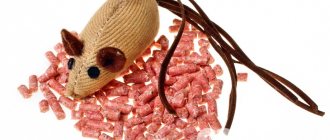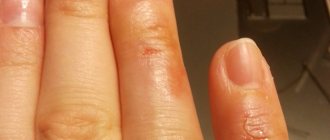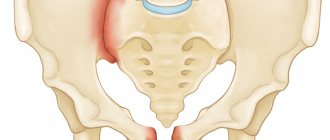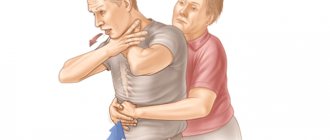Classification of false croup
The entire variety of false croup can be classified into viral and bacterial, as well as complicated and uncomplicated. However, most often false croup is classified depending on the degree of stenosis. If first-degree stenosis (or compensated stenosis) is detected, doctors note inspiratory shortness of breath during exercise or anxiety. If the second degree of stenosis (or subcompensated stenosis) is detected, then inspiratory dyspnea will be observed not only during physical exertion, but also in a calm state. The third degree of stenosis (decompensated type) manifests itself in the form of severe shortness of breath and paradoxical breathing. The fourth degree of stenosis (terminal degree) is characterized by severe hypoxia, which can lead to death.
Causes and pathogenesis of false croup
Perhaps the most common cause of false croup is one or another viral infection. These viruses include all kinds of influenza viruses, measles, parainfluenza, herpes, whooping cough and chickenpox. It should be said that false croup can also be a consequence of acute chronic tonsillitis. In addition, the disease can be caused by the weakened state of the child’s body due to a possible birth injury or previous rickets (diathesis, fetal hypoxia, etc.). Artificial feeding, reduced immunity, vitamin deficiency - all these are possible causes of false croup.
False croup differs from ordinary laryngitis by an inflammatory change accompanied by stenosis. False croup may be accompanied by laryngeal stenosis. The main reasons for its development are pathogenetic mechanisms. It should be said that during the course of false croup, inflammation of the larynx is usually expressed in the form of swelling under the vocal cords. The latter leads to a narrowing of the lumen of the larynx in this area. Next, a spasm of the constrictor muscles is observed, which is a reflex. It is this spasm that aggravates laryngeal stenosis. It must also be remembered that this disease may be accompanied by an increase in the secretion of the glands of the laryngeal mucosa, which leads to the formation of a significant amount of viscous sputum. Such sputum obstructs the narrowed area of the larynx. All this explains the development of obstructive syndrome, in other words, a violation of the passage of air through the respiratory tract. At the beginning of the appearance of false croup, compensation occurs for the insufficient amount of oxygen supplied due to the good functioning of the respiratory muscles, which enhance breathing. In the case of an increase in the degree of stenosis, as well as obstruction, the appearance of a stage of decompensation is possible. The result of pronounced stenosis in conditions of false croup can be hypoxia (or oxygen starvation). The latter can cause disruption of the central nervous system and cardiovascular system.
Symptoms
If you notice the first signs of this disease in a child, then it is necessary to take the most urgent measures possible, because this disease, if left unattended, can directly threaten not only the health, but also the life of the child. So keep an eye out for these signs as closely as possible:
- The child suffers from difficulty breathing all day long. It is often ignored by parents; it seems to them that it is just a weak hoarseness, but at night severe attacks of suffocation begin.
- Before this, the child experiences shortness of breath. If he usually made about 30 respiratory movements per minute, now they become about 50. This shortness of breath is present in order to compensate for the lack of oxygen that occurs with this disease.
- After this, a cough begins, which is barking and annoying in nature. It exists to remove phlegm, which is formed in large quantities during the progression of this disease.
Signs of true and false croup
The stronger the inflammatory reaction in the larynx, the more pronounced the symptoms of false croup.
But this is only the main symptomatology. If the problem develops against the background of an infectious disease, then the temperature may additionally increase. If the development occurs against the background of an allergic reaction, then itchy rashes may appear on the skin.
After this, if the disease was not promptly captured, additional symptoms appear that are directly related to the developing oxygen deficiency. Increased heart rate, excitement or, conversely, lethargy, blue lips and fingers - all these are characteristic signs that not everything is in order with the child’s body at the moment, therefore it is necessary to urgently take measures to cope with this pathological condition.
Symptoms of false croup
As a rule, false croup reaches its development on the 2nd or 3rd day of the acute form of an infectious disease of the upper respiratory tract. Typical symptoms of croup immediately appear, including a loud, barking cough, hoarse voice, and noisy breathing (stridor). The latter is a consequence of narrowing of the lumen of the larynx. Also, as a rule, inspiratory type of shortness of breath is observed. As for the degree of increase in body temperature, it depends on the type of pathogen and the body’s reaction to it. Both low-grade fever (usually occurs with parainfluenza infection) and body temperature of about 40 degrees may be observed. When examining a child, doctors often detect enlarged cervical lymph nodes. When inhaling, the patient may experience whistling dry rales.
Of course, the clinical picture of false croup depends on the degree of detected laryngeal stenosis. So, for example, the first degree of stenosis is characterized by shortness of breath only during physical activity or when the child is restless. With the help of auscultation, a long breath and wheezing can be detected, which usually appear only when inhaling.
The second degree of stenosis is characterized by the fact that shortness of breath appears at rest. When inhaling, a so-called retraction of the jugular fossa is observed (and there may also be intercostal spaces). Doctors may listen for dry rales. Another important symptom at this degree is the blue color of the nasolabial triangle, which indicates oxygen starvation. Sleep disturbances, unreasonable agitation, and tachycardia may also occur.
The third degree is characterized by the following symptoms: the occurrence of severe inspiratory dyspnea with possible retraction of the jugular fossa, as well as the epigastric region, during breathing; pronounced barking cough; paradoxical breathing. Mixed shortness of breath may also be observed, which is not a good sign in the prognosis of this disease. Cyanosis is diffuse in nature, the pulse is difficult to palpate, has a thread-like character with a particular loss on inspiration. Another symptom may be tachycardia. With this degree of stenosis, the child’s behavior can be both restless and inhibited. The child may be sleepy. Confusion may also occur. When listening to a doctor, wet and dry rales of different “calibers” are usually heard, and muffled heart tones are revealed.
As for the fourth degree, it is characterized by a usually absent barking cough and noisy breathing. Characteristic symptoms for this degree of stenosis are arrhythmic shallow breathing, bradycardia and arterial hypotension. Convulsions may occur. The consciousness of a child with the 4th degree of stenosis is quite confused and can turn into a hypoxic coma. In world practice, there are cases where patients with false croup died from the disease. The latter can be explained by the development of asphyxia.
It should also be said about a distinctive feature, which is the occurrence of croup with a modified severity of obstructive syndrome, as well as inspiratory dyspnea over the next day, and the latter can be either well-defined or almost imperceptible. The most severe condition of the patient is observed at night. At night, the patient may suffer from attacks of false croup caused by laryngeal stenosis. The main symptoms are the following: a feeling of suffocation, fear and excitement of the child, shortness of breath, specific cough, perioral cyanosis, pallor.
Prevention
The situation with false croup is monitored internationally. There is a specific prevention of true croup, which is carried out en masse. We are talking about mass vaccination of babies starting from 3 months. Moreover, to prevent the clinical manifestations of false croup, nonspecific measures play an important role. It is necessary to eat right, toughen up, and lead a healthy lifestyle. At the first signs of infection, you need to contact a specialist as soon as possible, because emergency care is the only chance for life for a patient with croup.
Staying at home is a high risk of death. No one will ever be able to carry out correct treatment at home, so only emergency hospitalization is an opportunity to survive.
Diagnosis of false croup
False croup is usually diagnosed by a pediatrician or otolaryngologist. Diagnosis is made on the basis of a typical clinical picture for false croup, anamnesis data obtained and other results of examination and listening of the lungs. Additionally, microlaryngoscopy may be prescribed, as well as bacterial culture of a smear (from the throat) in order to identify and determine the nature of the pathogen. In order to determine mycoplasma and chlamydial flora, a doctor may prescribe ELISA or PCR. If it is necessary to identify a fungal infection, smear microscopy is prescribed, as well as culture on Sabouraud’s medium. The severity of hypoxia can be assessed through an analysis to determine the acid-base state (ABS), as well as the gas composition of the blood. Diagnostics includes pharyngoscopy, x-ray of the lungs, rhinoscopy and otoscopy, x-ray of the paranasal sinuses.
Diagnostics
To diagnose treatment, you will need the help of an otolaryngologist, therapist or pediatrician. If complications are observed in the bronchi or lungs, the patient will also be referred to a pulmonologist. In the presence of laryngeal tuberculosis, the examination is carried out jointly with a phthisiatrician, in case of syphilis with a venereologist, respectively.
To diagnose croup you will need:
- characteristic clinic,
- laryngoscopy and auscultation data,
- medical history,
- additional research.
Auscultation of the lungs allows you to listen to dry wheezing rales. Wet wheezing signals the aggravation of the painful condition. The laryngoscopy picture will allow you to assess the extent of the inflammatory process, how much the larynx is narrowed, and also reveals fibrinous films that are characteristic of diphtheria. Microscopy and analysis of throat smears (bacteria culture) make it possible to verify the causative agent of the infection. Syphilis is detected using the RPR test. A blood test allows you to judge at what stage of the disease the patient is. If complications develop, the child must undergo otoscopy, pharyngoscopy, chest x-ray, lumbar puncture or rhinoscopy, depending on the nature of the complications.
For whooping cough, retropharyngeal abscess, bronchial asthma and laryngeal tumors, a differential diagnosis of croup is carried out.
Differential diagnosis of false croup
The primary thing in identifying false croup is its differentiation from true croup. As is known, diphtheria croup is characterized by a slow but progressive increase in previously occurring laryngeal stenosis. The latter may be accompanied by dysphonia, up to the absence of voice. Also, the course of false croup may be accompanied by a voice disorder, but there is no possibility of complete aphonia. As for true croup, it can make the voice stronger. With false croup, the voice may also become stronger.
The best way to diagnose the diphtheria type of croup is by detecting the presence of diphtheria plaque during an examination of the larynx, as well as by detecting the causative agent of diphtheria during a bacteriological examination of a taken smear.
Typically, false croup is differentiated from other diseases accompanied by laryngeal stenosis by the following manifestations: laryngeal edema of an allergic nature, the presence of a foreign body in the larynx, retropharyngeal abscess, acute epiglotitis, possible tumor of the larynx, congenital stridor, attacks of bronchial asthma.
Treatment of false croup
The main treatment for children with false croup is to prevent and relieve an attack of laryngeal stenosis, as well as relieve inflammation and swelling of the subglottic area. Treatment involves eliminating any influence of factors that provoke the occurrence of an attack. It is also necessary to provide access to fresh air. The patient needs to drink plenty of fluids and avoid foods that irritate the throat. It is best for the patient to take medications in the form of syrups during the treatment period. The doctor also prescribes absorbable tablets, various aerosols and inhalations. If false croup is characterized by a nonproductive cough, then the doctor usually prescribes antitussive drugs such as codeine, noscapine, codelac, tusuprex, coldrin and others. Antihistamines can also be prescribed, including diphenhydramine, diazolin and fenkarol. Such drugs have an antitussive effect and at the same time relieve swelling. If we talk about false croup, characterized by pronounced stenosis of the larynx, then its treatment is carried out using sedatives, glucocorticoids and antispastic drugs. From the very first day of the disease, antibiotics are prescribed. As for the treatment of false croup of a viral nature, it is carried out with the help of antiviral drugs. If the patient experiences an attack of reflex spasm of the larynx, which is so characteristic of false croup, then providing first aid to the patient will consist of pressing on the root of the tongue in order to provoke a gag reflex. Hot foot baths and warm compresses in the larynx and chest area are also effective. Sometimes they put cans on their backs.
Croup in children - what to do?
False croup in children is a dangerous disease that requires urgent medical attention. Croup in children, the symptoms and treatment of this disease fall under the competence of an infectious disease doctor, so the child is hospitalized in the infectious diseases department. The danger of croup is that it develops quickly and affects the vital function of breathing. Before treating a child's croup, parents should rush to call an ambulance. At the same time, you should not panic and scare the child, because the emotion of fear and crying will aggravate the situation.
First aid for croup in children
Only medical workers can provide full assistance to a child with croup, but since time is limited in this case, parents must take some measures before help arrives.
First aid for croup
- Sit the baby down or pick him up - the vertical position weakens laryngospasm.
- Distract the baby so that he does not cry or be capricious.
- Let fresh air into the room, while wrapping the child up so he doesn’t freeze.
- Give the child a warm drink.
- Give your baby a warm foot or hand bath to dilate blood vessels. Heat should not be applied to the chest.
- If the ambulance team is delayed, it is necessary to give the child an antihistamine (Loratadine, Claritin, Diazolin, Fenkarol, Tavegil), an antispasmodic (No-shpa, Drotaverine). You can give your baby Bronchoril or Instaril. If there is an inhaler with Salbutamol in the house, then you should spray the drug into the air near the child.
How to treat croup in children?
Treatment of croup in children takes place in a hospital setting. If doctors have diagnosed croup in a child, first aid will be to relieve spasm and reduce swelling of the airways. At the same time, work is underway to cure the underlying disease that caused croup in the child. The hospital provides the following treatment:
- Administration of glucocorticoids (Prednisolone) necessary to relieve laryngeal edema. They are often administered using a nebulizer.
- The use of drugs that relieve spasm of the respiratory tract: Salbutamol, Ventolin, Atrovent.
- If necessary, doctors may use sedatives.
- Inhalations with Ambroxol help relieve mucus discharge.
- Antihistamines are intended to reduce allergic reactions and relieve swelling.











